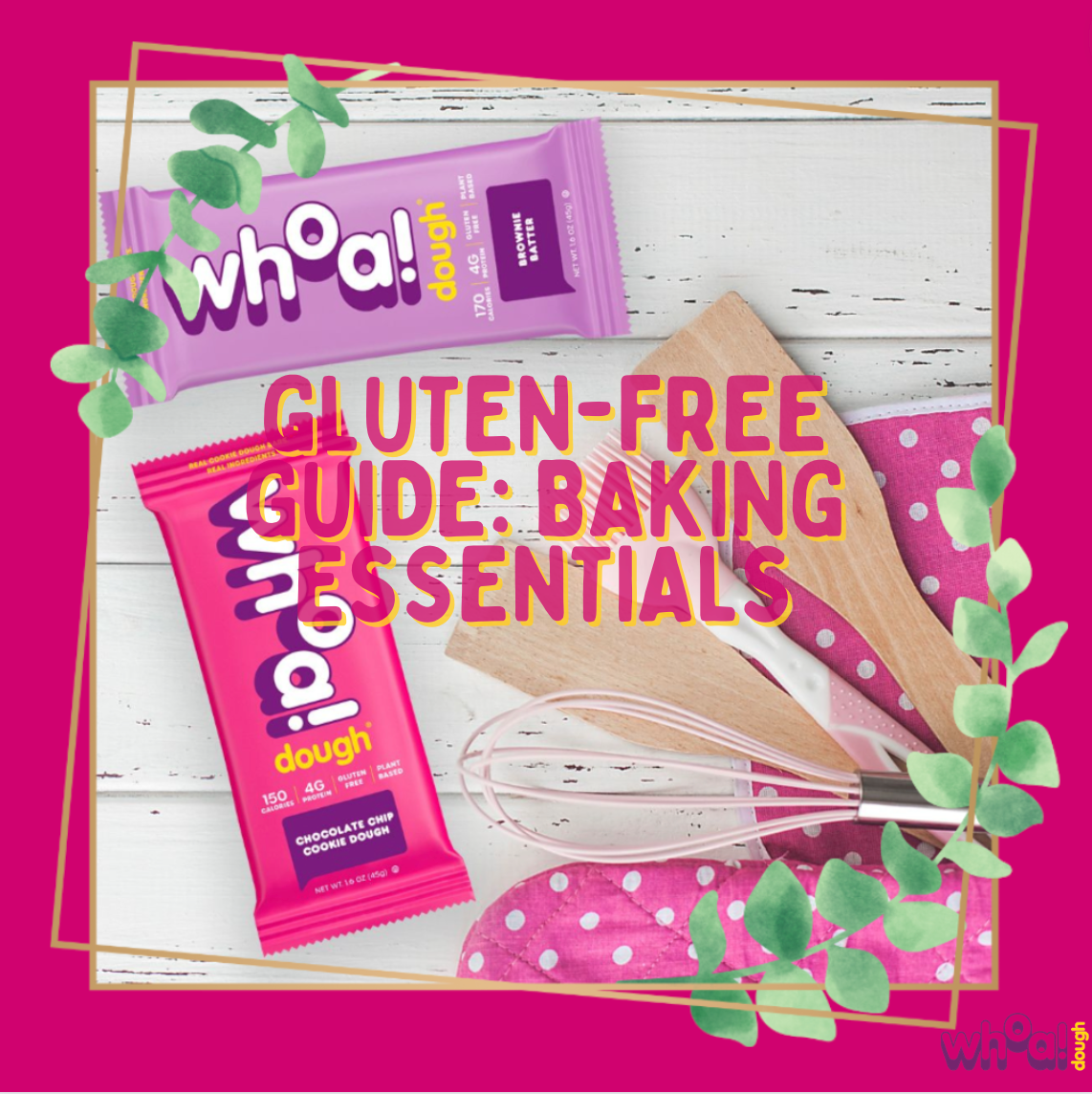Are you looking to take up baking but unsure what essentials you should have in your pantry? Not only will this article give you some great gluten-free brands to always have on hand, but it will also give you some tips on how to bake using healthier ingredients. So, whether you are gluten-free, or just trying to prepare some guiltless homemade sweets, you’ve come to the right place.
To begin, it is first important to identify the necessary components you will use for every baked treat. This includes flour, oil, a binding agent, and a sweetener. You also are going to want to have some good add-ins on hand, because let's be real, 99% of the time the add-ins make the recipe (who wants to have chocolate chip cookies without the chocolate chips?). Now that we have identified the key constituents of a baked good, let’s list some gluten-free, healthy alternative swaps that we can use:
FLOUR
1) Bob’s Red Mill Gluten-Free 1-to-1 Baking Flour
Now this is going to be your best choice if you are looking for something that tastes most like your typical baking flour. It is also going to be the easiest choice if you are following a recipe that is not already gluten-free (whereby you are converting the ingredients to gluten-free on your own). A lot of times when baking with different types of flour, you will have to change ratios of the recipe in order to make it fit with the new flour. However, using Bob’s Red Mill Gluten-Free flour, that does not seem to be an issue.
2) Almond Flour
My personal favorite flour swap has to be almond flour. I personally love the texture it brings to most recipes, adding a tiny essence of nuttiness to your baked goods. Now, if you aren’t a nut fan: don’t be frightened! I promise that you cannot tell your baking with grinded-up almonds. If anything, the added nutty-like texture it brings is a whole new flavor profile! As far as brands go, I personally tend to gravitate towards Bob Red Mill’s Unblanched Almond Flour.
3) Oat Flour
Another great gluten-free flour swap is oat flour, especially if you are looking for the most affordable option. You can even make it yourself by blending some gluten-free oats. Oat flour holds a dear place in our hearts, as it is the main base in our delicious Whoa Dough Bars! If this doesn’t tell you how tasty oat flour can make recipes, then I don’t know what else can.
OIL
1) Coconut Oil
My favorite baking oil is most definitely coconut oil. Coconut oil is not only flavorful, but it adds a great nutrition component to your baked goods. Did you know that coconut oil contains MCTs, a saturated fat linked to an increase in calorie burn? (https://www.healthline.com/nutrition/top-10-evidence-based-health-benefits-of-coconut-oil#TOC_TITLE_HDR_4)
2) Avocado Oil
Avocado oil is great due to its high smoke point. It can withstand heat up to 520ºF without getting chemically altered. Avocado oil only brings a mild flavor profile, and seems to be one of the more neutral tasting oils within a recipe. As far as brands go, I tend to use Primal Kitchen’s Avocado Oil because it is made purely of avocado oil. Be on the lookout for brands that add unnecessary fillers to their oils.
3) Olive Oil
Olive oil is always a great option when you don’t have anything else on hand. The smoking point is quite lower when compared to avocado oil, but it is still a great alternative to most vegetable oils. Some people report a mild taste associated when baking with olive oil, but I personally never seem to taste it. Primal Kitchen makes great olive oil as well!
BINDING AGENT
1) Banana
When in doubt, banana it out! I don’t know about you, but I tend to ALWAYS have ripening bananas on hand. I never seem to eat my bananas fast enough before the majority of them turn into mush. Good news though– you can use these blackening bananas as a binding agent in your recipes! This swap is more directed to vegans, but it can also just be viewed as a healthier swap to eggs (and of course it is gluten-free as well). The best part is, the banana makes the final product super moist!
2) Unsweetened Apple Sauce
Similar to banana, unsweetened applesauce can be used as an egg substitute. While I feel bananas create a better texture within the baked good, applesauce tends to have a less potent flavor than bananas. Thus, if you are not much of a banana fan, applesauce may be the better option for you.
3) Flax/Chia seeds
Another popular egg replacement is flax or chia seeds. I cannot vouch for this one quite as well, as I don’t typically use it myself, but it seems to be a great and nutritious alternative. The only downside to this is that you have to prep it, which if you are lazy like myself, you don’t always feel like taking the time to do. To use flax or chia seeds as a binding agent, you have to combine 1 tbsp flaxmeal/ chia seeds with 3 tbsp of water and let refrigerate for at least 15 minutes.
SWEETNER (Granulated)
1) Coconut Sugar
Coconut sugar is my absolute favorite granulated sweetener to use in recipes. It is a natural, plant-based sweetener that is significantly better for your blood sugar levels compared to regular table sugar. It also contains various more vitamins and minerals than your typical processed sugar.
2) Maple Sugar
Like coconut sugar, maple sugar is another great natural sweetener. There aren’t too many differences between the two, however maple sugar seems to be pricier and harder to find than coconut sugar.
3) Zero Sugar Alternates
If you are looking for a granulated sweetener that does not actually contain sugar (or calories for that matter), then I have a couple good options for you. A lot of sugar substitutes can actually be a lot worse for you than regular sugar (like splenda), but there are a few safer ones out there. I personally like to use Swerve Brown Sugar or Lakanto Monk Fruit. A lot of people also recommend stevia, although I tend to think it has an overpowering taste.
SWEETENER (Liquid)
1) Maple Syrup
Maple syrup is one of the best sweeteners in my opinion when looking for a healthier, natural alternative. I find the flavor it adds to be exquisite and not too overpowering. It also works great to help bind recipes together.
2) Date Syrup
I haven’t experimented too much with date syrup, but I have heard a lot of good things surrounding Just Date Syrup. It is very similar to maple syrup, but the dates tend to add more of a caramel-esk flavor.
3) Honey
Honey is one of the more popular natural sweeteners. However, I am not too big of a fan of honey, so if you ask me, it ranks comparatively lower on the list. Honey also tends to be a deal-breaker for most vegans. However, if you like honey and you are looking for a healthier sugar swap, don’t sleep on honey.
ADD-INS
Rather than list types of add-ins to use, I am just going to list a few great gluten-free brands (because, well, most add-ins are going to be chocolate chips anyways).
1) Enjoy Life
2) Unreal
3) HuKitchen
4) Lily’s
I hope you enjoyed this list of baking alternatives! Whether you are gluten-free, vegan, or just looking for healthier baking ingredients, this list should serve you well.


0 comments